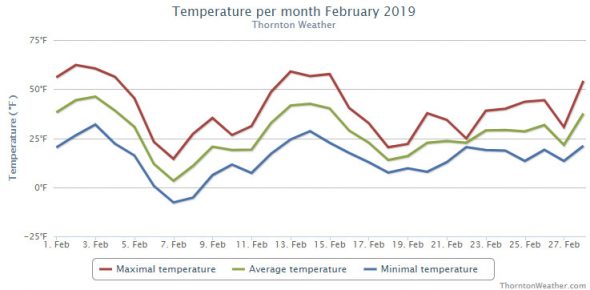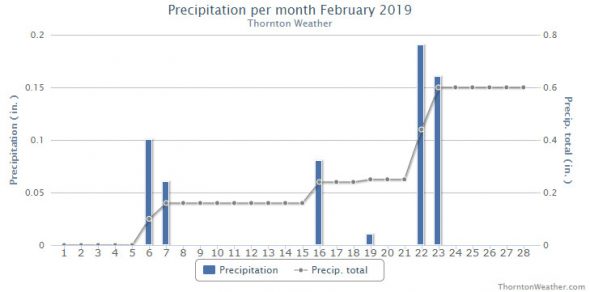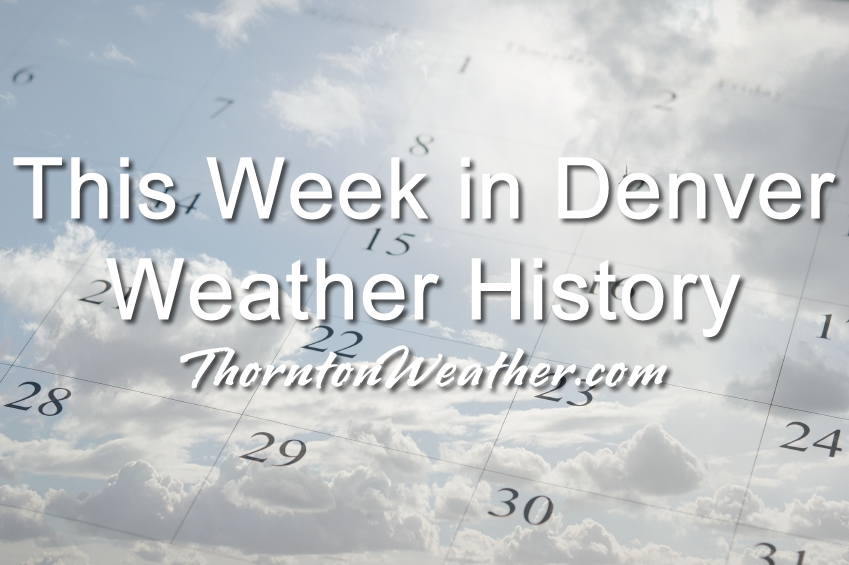
Wind is arguably one of the most frustrating weather conditions and living on the plains of Colorado it is a relatively common occurrence. During February downslope flow brings Chinooks that can create mild temperatures but also can be incredibly powerful. Our look back at this week showcases a number of high wind events that caused extensive damage.
From the National Weather Service:
15-16
In 1889…heavy snowfall totaled 6.7 inches in downtown Denver. Most of the snow…5.5 inches…fell on the 15th when northeast winds were sustained to 18 mph.
In 1921…strong bora winds cooled maximum temperatures from the 60’s on the previous 3 days to 54 degrees on the 15th and to 43 degrees on the 16th. West winds were sustained to 39 mph with gusts to 54 mph on the 15th and to 46 mph with gusts to 56 mph on the 16th.
In 1953…strong…cold northwest winds were widespread from the foothills across the plains. Near gale force winds were observed in Boulder. A wind gust to 54 mph was recorded at Stapleton Airport where blowing dust briefly reduced the visibility to 1 1/2 miles. Damage was minor.
In 1993…an arctic cold front pushed south over the eastern Colorado plains with upslope snow developing behind the front. Snowfall amounts of 3 to 6 inches were common over metro Denver. At Stapleton International Airport…snowfall totaled 4.5 inches and north winds gusted to 25 mph. Temperatures hovered only in the single digits for most of the day. The storm produced up to a foot of snow over southeast Colorado.
In 2006…overnight snowfall in the mountains and eastern foothills contained a lot of red dust and dirt apparently from Arizona. Strong southwest winds with gusts to 100 mph in the San Juan Mountains on the 15th created widespread blowing dust. This red dust became entrained in snowfall across the area. The reddish colored snow was reported in Ward…Nederland…Blackhawk…and Boulder. The storm produced only 0.9 inch of snowfall in the Stapleton area of Denver with 4 to 5 inches measured in the foothills.
15-17
In 1938…a cold air mass brought a light snowfall of 6.2 inches over 3 days to downtown Denver where northeast winds were sustained to 18 mph on the 15th.
16
In 1879…a sudden burst of 3 inches of snow in less than 90 minutes stopped the street cars in downtown Denver during the late afternoon. Melted snow resulted in 0.16 inch of precipitation. Small soft hail also fell when the snow began. A gentleman caught on the prairie between Denver and Morrison described the event as the most severe storm of the winter while it lasted.
In 1885…a windstorm caused severe damage in the city. The strong winds blew all afternoon and most of the evening. West winds were sustained to 62 mph. The strong winds blew down signs and broke windows. Buggies and vehicles of all kinds were blown over. Smokestacks and chimneys were toppled. Roofs were blown off. The Denver and Rio Grande Railroad car shop was partially unroofed and had a wall blown down. Three railroad cars were blown off the track. Many fences were damaged.
In 1897…west winds were sustained to 46 mph with gusts to 56 mph.
In 1912…northwest winds were sustained to 44 mph with a measured extreme velocity to 45 mph.
In 1921…west winds were sustained to 46 mph.
In 1972…wind gusts to 58 mph were recorded at the National Bureau of Standards in Boulder. In downtown Boulder…a wind gust to 51 mph was measured. Northwest winds gusted to 41 mph at Stapleton International Airport.
In 1988…snowfall totaled 3 to 6 inches across metro Denver… But 9 inches were measured in both Wheat Ridge and Evergreen. At Stapleton International Airport…3.4 inches of snow fell and northeast winds gusted to 26 mph. The strong winds blew a scaffold against a hotel in downtown Denver…breaking three windows.
In 1995…high winds occurred in the foothills behind a departing winter storm. A wind gust to 91 mph was recorded at Rollinsville with a gust to 82 mph atop Squaw Mountain west of Denver. West winds gusted to only 20 mph at Stapleton International Airport.
In 2014…a peak wind gust to 59 mph…from the west…was recorded at Denver International Airport.
16-17
In 1929…strong west winds gusting to 84 mph raked Boulder and Lafayette. Limited minor damage and a few injuries occurred.
In 1986…strong Chinook winds continued to howl in the foothills. A wind gust to 89 mph was recorded at Table Mesa in Boulder on the 16th. Winds of 60 to 75 mph were clocked at other locations in Boulder on both days. A west wind gust to 51 mph was recorded at Stapleton International Airport on the 16th.
In 2014…high winds developed briefly overnight in and near the foothills of Boulder and Jefferson Counties. Peak wind reports included: 98 mph…4 miles north-northwest of White Ranch Open Space; 85 mph at the NCAR Mesa Lab; 78 mph at the Junction of Colorado Highways 93 and 172; and 75 mph just southeast of Morrison. A semi-truck and an SUV pulling a trailer were rolled over by the wind on Colorado 470 near Morrison. Strong winds damaged a home under construction in Lakewood.
16-18
In 1970…a wind gust to 90 mph was recorded in Boulder at the National Center for Atmospheric Research. In downtown Boulder…sustained winds of 30 to 40 mph with gusts to 53 mph were measured. Damage was minor. West winds gusted to 45 mph at Stapleton International Airport on the 17th. The strong Chinook winds warmed the temperature to 70 degrees on the 16th and to 72 degrees on the 17th…both records for the date. The low temperature dipped to only 32 degrees on the 16th equaling the record high minimum for the date.
17
In 1887…west winds were sustained to 64 mph. Strong winds occurred all day long in the city. Rainfall was 0.02 inch.
In 1894…northwest winds were sustained to 40 mph with gusts to 46 mph.
In 1937…northwest winds sustained to 36 mph with gusts to 44 mph started a few minor fires and broke a number of plate-glass windows in downtown Denver office buildings.
In 1962…heavy snowfall totaled 7.5 inches at Stapleton Airport where the visibility was reduced to as low as 1/4 mile at times. Winds gusted from the northeast at only 15 mph.
In 2009…strong prefrontal wind gusts knocked down some trees and power lines in Boulder. More than 3400 Xcel customers in the University Hill area were without power for about one hour. Peak wind gusts included 68 mph at the NCAR Mesa Lab and 60 mph in Boulder.
17-18
In 1976…a strong cold front produced wind gusts 30 to 60 mph with much blowing snow and severe dust storms. In the Boulder area…high winds collapsed a garage and broke some windows. Northwest winds gusted to 43 mph on the 17th and to 44 mph on the 18th at Stapleton International Airport.
In 1984…the third blizzard in a week struck eastern Colorado. Heavy snow hit some parts of metro Denver with 8 to 10 inches measured in Aurora…but only 2.9 inches of snow fell at Stapleton International Airport where northwest winds gusted to 31 mph.
In 1999…damaging downslope bora winds developed in the foothills behind a strong cold front. Peak wind reports included: 90 mph at the Gamow Tower on the University of Colorado campus in Boulder; 79 mph at the National Center for Atmospheric Research mesa lab near Boulder and at the national wind technology center south of Boulder; and 72 mph atop Blue Mountain and at Jefferson County Airport. Downed power lines caused major outages for at least 10 thousand residents in Evergreen…Idaho Springs…Golden… And Lakewood. In Golden…the wind toppled a lightning static protection line atop a 70-foot…230 thousand-volt distribution tower. The downed line…sparked a small grass fire just east of the Lookout Mountain Youth Services Center. The fire burned a path approximately 100 yards wide and 1/3 mile long before it was contained.
In 2000…snow…heavy in the mountains and foothills…spread over metro Denver. Snowfall totaled 24 inches at the Eldora Ski Resort with 8 inches measured near Blackhawk. Snowfall was only 1.8 inches at the site of the former Stapleton International Airport…which was the only measurable snow of the month.
17-19
In 2006…a cold spell resulted in 4 temperature records. Low temperatures of 10 degrees below zero on the 17th… 13 degrees below zero on the 18th…and 4 degrees below zero on the 19th were record minimums for those dates. The high temperature of only 7 degrees on the 18th was a record low maximum for the date. Light snow fell on the 17th…but totaled less than half an inch at Denver International Airport.
18
In 1918…post-frontal northwest winds were sustained to 40 mph with a measured extreme velocity to 44 mph.
In 1937…a moderate duststorm occurred during the late afternoon and early evening. Northeast winds sustained to 32 mph with gusts to 41 mph reduced the visibility to 1/2 mile which persisted for about 40 minutes in the city.
In 1998…rare thunder from instability rain and snow showers was heard in Littleton during the late afternoon. Thunder in February only occurs about once every 10 years over metro Denver.
18-19
In 1954…a vigorous cold front produced north winds gusting to 56 mph and a trace of snowfall at Stapleton Airport on the 18th. Strong and gusty winds to 55 mph persisted through the next day and caused some blowing dust.
In 1955…a storm dumped heavy snow across metro Denver. At Stapleton Airport where north winds sustained to 28 mph produced some blowing snow…snowfall totaled 8.8 inches.
18-20 in 1913…post-frontal snowfall totaled 6.9 inches in downtown Denver over the 3 days. Most of the snow fell on the 19th. Northeast winds were sustained to 21 mph with a measured extreme velocity to 24 mph on the 18th.
In 1924…light snowfall totaled 4.6 inches over the 3 days. This was the only measurable snowfall of the month. High temperatures plunged from 45 degrees on the 18th to 17 degrees on the 20th. Low temperatures dipped from 31 degrees on the 18th to only 8 degrees on the 20th. Northeast winds were sustained to 24 mph on the 19th.
In 1953…a major blizzard dumped 10.6 inches of snowfall at Stapleton Airport. Strong north winds at sustained speeds of 25 to 35 mph with gusts as high as 44 mph frequently reduced visibilities to 1/4 mile in blowing snow during the day of the 19th. The strong winds caused much drifting snow…making accurate snowfall measurements almost impossible. Precipitation from the storm totaled 1.13 inches. The 1.01 inches of precipitation on the 19th was the greatest calendar day and 24 hour precipitation ever recorded in the city during the month of February.
In 1987…large amounts of new snow fell in the Front Range foothills. The foothills received 10 to 20 inches of new snow with 4 to 8 inches on the adjacent plains. On the 19th…flight delays occurred at Stapleton International Airport where snowfall totaled 4.2 inches and east winds gusted to only 18 mph on the 19th. Schools were closed in the foothills above Boulder.
Continue reading February 16 to February 22: This Week in Denver Weather History →



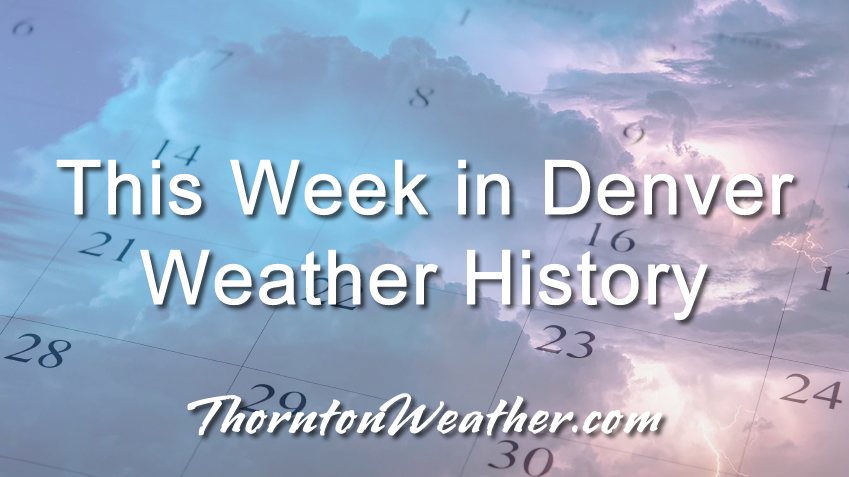
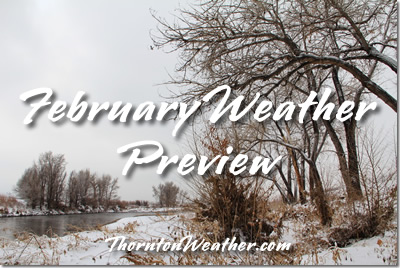 February in Colorado typically brings to an end an extended period when average temperatures are at their lowest. Winter begins to loosen its grip and temperatures get warmer but precipitation is not a particularly common event during the month.
February in Colorado typically brings to an end an extended period when average temperatures are at their lowest. Winter begins to loosen its grip and temperatures get warmer but precipitation is not a particularly common event during the month.